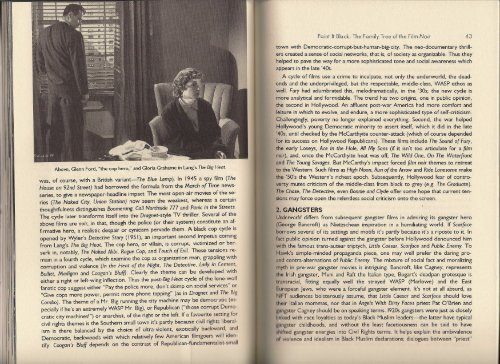Raymond Durgnat, “Paint It Black: The Family Tree - Get a Free Blog
Raymond Durgnat, “Paint It Black: The Family Tree - Get a Free Blog
Raymond Durgnat, “Paint It Black: The Family Tree - Get a Free Blog
Create successful ePaper yourself
Turn your PDF publications into a flip-book with our unique Google optimized e-Paper software.
Above, Glenn Ford, "the cop hero," and Gloria Grahame in Lang's <strong>The</strong> Big Heat.<br />
was, of course, with a British variant-<strong>The</strong> Blue Lamp). In 19-45 a spy film (<strong>The</strong><br />
House on 92nd Street) had borrowed the formula from the March of Time newsseries,<br />
to give a newspaper-headline impact. <strong>The</strong> most open-air' movies of the series<br />
(<strong>The</strong> Naked City, Union Station) now seem the weakest, whereas a certain<br />
thoughtfulness distinguishes Boomerang, Call Northside 777 and Panic in the Streets.<br />
<strong>The</strong> cycle later transforms itself into the Dragnet-style TV thriiller. Several of the<br />
above films are noir, in that, though the police (or their system) constitute an affirmative<br />
hero, a realistic despair or cynicism pervade them. A black cop cycle is<br />
opened by Wyler's Detective Story (1951), an important secomd impetus coming<br />
from Lang's <strong>The</strong> Big Heat. <strong>The</strong> cop hero, or villain, is corrupt, victimized or berserk<br />
in, notably, <strong>The</strong> Naked Alibi, Rogue Cop. and Touch of Evil. <strong>The</strong>se tensions remain<br />
in a fourth cycle, which examine the cop as organization man, grappling with<br />
corruption and violence (In the Heat of the Night. <strong>The</strong> Detective. Lady in Cement.<br />
Bullitt. Madigan and Coogan's Bluff). Clearly the theme can Ibe developed with<br />
either a right or left-wing inflection. Thus the post-Big Heat cycle of the lone-wolf<br />
fanatic cop suggest either "Pay the police more, don't skimp om social services" or<br />
"Give cops more power, permit more phone tapping" (as in Dragnet and <strong>The</strong> Blf]<br />
Combo). <strong>The</strong> theme of a Mr. Big running the city machine may be democratic (a<br />
pecially if he's an extremely WASP Mr. Big), or Republican ("those corrupt Demo<br />
cratic city machines!") or anarchist, of the right or the left. If a favourite setting fOI<br />
civil rights themes is the Southern small town it's partly because civil rights liberal<br />
ism is there balanced by the choice of ultra-violent, exotic;ally backward, nnd<br />
Democratic, backwoods with which relatively few American filmgoers will ldcn<br />
tify. Coogan's Bluff depends on the contrast of Republican-flundamentalist.sm,,11<br />
Paint <strong>It</strong> <strong>Black</strong>: <strong>The</strong> <strong>Family</strong> <strong>Tree</strong> of the Film Nair 43<br />
town with Democratic-corrupt-but-human-big-city. <strong>The</strong> neo-documentary thrillers<br />
created a sense of social networks, that is, of society as organizable. Thus they<br />
helped to pave the way for a more sophisticated tone and social awareness which<br />
appears in the late '40s.<br />
A cycle of films use a crime to inculpate, not only the underworld, the deadends<br />
and the underprivileged, but the respectable, middle-class, WASP ethos as<br />
well. Fury had adumbrated this, melodramatically, in the '30s; the new cycle is<br />
more analytical and formidable. <strong>The</strong> trend has two origins, one in public opinion,<br />
the second in Hollywood. An affluent post-war America had more comfort and<br />
leisure in which to evolve, and endure, a more sophisticated type of self-criticism.<br />
Challengingly, poverty no longer explained everything. Second, the war helped<br />
Hollywood's young Democratic minority to assert itself, which it did in the late<br />
'40s, until checked by the McCarthyite counter-attack (which of course depended<br />
for its success on Hollywood Republicans). <strong>The</strong>se films include <strong>The</strong> Sound of Fury,<br />
the early Loseys, Ace in the Hole. All My Sons (if it isn't too articulate for a film<br />
noir) , and, once the McCarthyite heat was off, <strong>The</strong> Wild One. On <strong>The</strong> Waterfront<br />
and <strong>The</strong> Young Savages. But McCarthy's impact forced film noir themes to retreat<br />
to the Western. Such films as High Noon. Run of the Arrow and Ride Lonesome make<br />
the '50's the Western's richest epoch. Subsequently, Hollywood fear of controversy<br />
mutes criticism of the middle-class from black to grey (e.g. <strong>The</strong> Graduate).<br />
<strong>The</strong> Chase. <strong>The</strong> Detective, even Bonnie and Clyde offer some hope that current tenions<br />
may force open the relentless social criticism onto the screen.<br />
2. GANGSTERS<br />
Underworld differs from subsequent gangster films in admiring its gangster hero<br />
(George Bancroft) as Nietzschean inspiration in a humiliating world. If Scarface<br />
borrows several of its settings and motifs it's partly because it's a riposte to it. In<br />
fnct public opinion turned against the gangster before Hollywood denounced him<br />
with the famous trans-auteur triptych, Little Caesar. Scarface and Public Enemy. To<br />
Hawk's simple-minded propaganda piece, one may well prefer the daring prond<br />
contra-alternations of Public Enemy. <strong>The</strong> mixture of social fact and moralizing<br />
myth in pre-war gangster movies is intriguing. Bancroft, like Cagney, represents<br />
he Irish gangster, Muni and Raft the <strong>It</strong>alian type, Bogart's deadpan grotesque is<br />
nsracial, fitting equally well the strayed WASP (Marlowe) and the East<br />
uropean Jews, who were a forceful gangster element. <strong>It</strong>'s not at all absurd, as<br />
NFT audiences boisterously assume, that Little Caesar and Scarface should love<br />
heir <strong>It</strong>alian mommas, nor that in Angels With Dirty Faces priest Pat O'Brien and<br />
ngster Cagney should be on speaking terms. 1920s gangsters were just as closely<br />
llnked with race loyalties as today's <strong>Black</strong> Muslim leaders-the latter have typical<br />
ngster childhoods, and without the least facetiousness can be said to have<br />
hlftod gangster energies into Civil Rights terms. <strong>It</strong> helps explain the ambivalence<br />
f vlelcncc and idcallsrn in <strong>Black</strong> Muslim declarations; dialogues between "priest"


